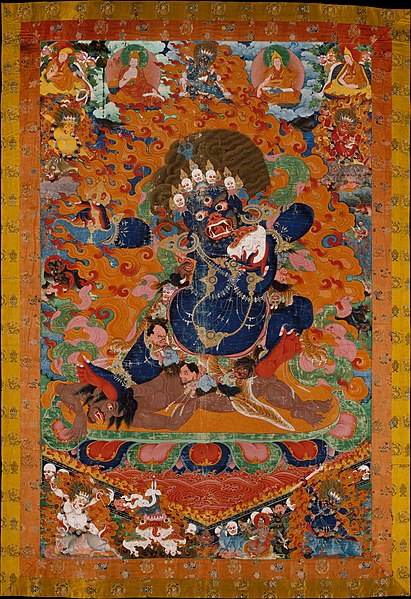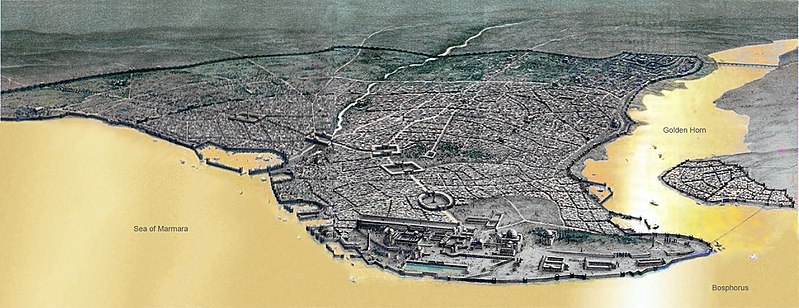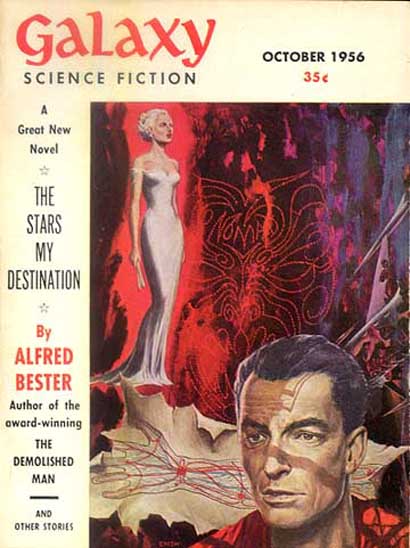1. This is a strange book, but it's organized well so it holds together. It chronicles a fictional history for mankind up to a specific point in the future. It's a large span of time that Stapledon is dealing with, and he organizes the time periods into eighteen main parts: seventeen different evolutionary variations on our humanity coming after his predictions for what would happen next in our world, the world of the first men. This organization is successful at keeping the whole project legible and varied.
2. It's structurally a good tactic to start here with the familiar, you and me as first men, then continue carefully and slowly away from that point, noting the early differences in detail. Then, by the time the reader gets to the eighteenth men, all of these crazy differences between us and them are palatable to the reader because they've seen the slow change over time in stages. This is a crazy book dealing with some inconceivable topics and states of being. But by showing the slow evolution, Stapledon allows the reader to understand his conception—by taking us one step at a time, I can follow much more easily.
3. However, he spends too much time on the first men. Even the intro to the version I read advised the reader to skip the first four parts due to their repetitiveness and their placing the book so specifically in 1930—plus, Stapledon gets some of his early prophecy very wrong. I also think too much time is spent on the first men: 37.5% of the book tells the story of the first men and the Martians, though the Martians only have a couple pages at best. This is what HP Lovecraft believed was a "disproportianate acceleration of the tempo towards the end." More time is spent on the first, second, fifth, and eighteenth men, while some of the later variations only receive a couple of sentences of description. Let me break down the pacing:
- the first 6 chapters are given over to the first men;
- chapters 7-9 to the second;
- chapter 10 to the third;
- chapter 11 to the fourth and fifth;
- chapter 12 the fifth alone;
- chapter 13 to the sixth, seventh, and eighth;
- chapter 14 to the ninth, tenth, eleventh, twelfth, thirteenth, fourteenth, fifteenth, sixteenth, and seventeenth;
- and the final two chapters, 15-16, to the eighteenth men.
4. The themes are evolution and genetic engineering, as well as man attempting to find man's place in the universe. And it's man's search that is Stapledon's project here. Through the 16 intervening species of men between the first and the last, each symbolizes characteristics of a philosophy that Stapledon is arguing against. Three examples:
- The fourth men are the most intelligent beings ever created. They think better than anybody, they govern with wisdom, and they are driven by objectivity. Empirical evidence is prime in their minds, and their thirst and passion for study is unrivaled. These are the smartest, wisest, brightest, and most objective beings that have ever been, and they're working together perfectly in a perfect commune. Yet, they have lost their humanity: love, sex, emotion, familial ties, competition, the easy ability to walk around. Through ignoring these basic human characteristics, they are wiped out. In other words, pure intellectualism uninformed by emotion is a philosophical dead end. As attractive as it seems from our perspective, Stapledon imagines that the true philosopher Kings would end up ruling the people through tyranny. And he makes a convincing argument.
- Even the Martians who invade earth are a metaphor for a philosophy: their group mind and body representin mindless communism.
- At the end, even the 18th men still have questions to be answered. I assume that the 18th men embody Stapledon's personal philosophy: they have done away with guilt, they are sexually highly diverse and liberal, they're all philosophers and artists, they have the ability to act and think together in groups of 96 or as an entire species, they are immortal, and they can re-experience the past at will. In other words, Stapledon wants us to get to a place where our morals are less limiting to our intellect, where we appreciate the well done good and evil act alike, and where the only things left unanswered are what the future holds and what happens after death.
The ether ship is in a manner symbolic of our whole community, so highly organized is it, and so minute in relation to the void which engulfs it. The ethereal navigators, because they spend so much of their time in the empty regions, beyond the range of "telepathic" communication and sometimes even of mechanical radio, form mentally a unique class among us. They are a hardy, simple, and modest folk. And though they embody man's proud mastery of the ether, they are never tired of reminding landlubbers, with dour jocularity, that the most daring voyages are confined within one drop of the boundless ocean of space.Here he's talking about a perfectly unified society that is able to handle anything through their perfect community. Yet, when taken outside of that community and faced with an actual unknown, even a minor unknown like "two comets, and an occasional meteor," these people who draw their strength from insularity are crazed, diseased, emaciated, and half of them die. They have no defence against reality outside that of their community. In Stapledon's mind, insularity leads to inflexibility which leads to mental instability when confronted with something outside of one's conception or experience. This philosophical project of lining up different philosophies then shooting them down works for Stapledon. I must mention that some seem a little straw-mannish: essentially saying that a group realizes a failure is coming from a long way out because they are so logical, so they gracefully step out of the way. But these examples don't really detract too much.
Recently an exploration ship returned from a voyage into the outer tracts. Half her crew had died. The survivors were emaciated, diseased, and mentally unbalanced. To a race that thought itself so well established in sanity that nothing could disturb it, the spectacle of these unfortunates was instructive. Throughout the voyage, which was the longest ever attempted, they had encountered nothing whatever but two comets, and an occasional meteor. Some of the nearer constellations were seen with altered forms. One or two stars increased slightly in brightness; and the sun was reduced to being the most brilliant of stars. The aloof and changeless presence of the constellations seems to have crazed the voyagers. When at last the ship returned and berthed, there was a scene such as is seldom witnessed in our modern world. The crew flung open the ports and staggered blubbering into the arms of the crowd. It would never have been believed that members of our species could be so far reduced from the self-possession that is normal to us. Subsequently these poor human wrecks have shown an irrational phobia of the stars, and of all that is not human. They dare not go out at night. They live in an extravagant passion for the presence of others. And since all others are astronomically minded, they cannot find real companionship. They insanely refuse to participate in the mental life of the race upon the plane where all things are seen in their just proportions. They cling piteously to the sweets of individual life; and so they are led to curse the immensities. They fill their minds with human conceits, and their houses with toys. By night they draw the curtains and drown the quiet voice of the stars in revelry. But it is a joyless and a haunted revelry, desired less for itself than as a defence against reality.
5. Part of the reason that it works is he never loses sight of wonder. In the descriptions of each of the stages of man's evolution, in the descriptions of geological and universal time, in the short episodes of specific situations that ended up being important—Stapledon suffuses this book with a sense of wonder that I think is necessary to the readability of the dryer philosophical theme. If it was just straight philosophy, this project would have been better suited to an essay. But he wants to write it in this narrative form, so he fills it with life, wonder, and beauty. The marriage of these two actually ends up working very well. It's a big risk, not having characters and relying upon descriptions, world-building, and philosophy alone to interest the reader and drive the book. But Stapledon's descriptions allow wonder to carry the whole thing:
The sky turned black. The Arctic summer became a weird and sultry night, torn by fantastic thunderstorms. Rain crashed on the ship's deck in a continuous waterfall. Clouds of pungent smoke and dust irritated the eyes and nose. Submarine earthquakes buckled the pack-ice.I think the writing is good: it communicates well and has that perfect balance between specific detail and unstated mystery which allows wonder to seep into the text. It is evocative without being breathtakingly beautiful, but also without being ugly. As you can tell from the first paragraph quoted in point 4, there is a suspension of disbelief that the reader today must engage in order to fully enjoy this book. This was written in 1930 and some of the science shows it. But in all, the writing is solid.
A year after the explosion, the ship was labouring in tempestuous and berg-strewn water near the Pole. The bewildered little company now began to feel its way south; but, as they proceeded, the air became more fiercely hot and pungent, the storms more savage. Another twelve months were spent in beating about the Polar sea, ever and again retreating north from the impossible southern weather. But at length conditions improved slightly, and with great difficulty these few survivors of the human race approached their original objective in Norway, to find that the lowlands were a scorched and lifeless desert, while on the heights the valley vegetation was already struggling to establish itself, in patches of sickly green. Their base town had been flattened by a hurricane, and the skeletons of its population still lay in the streets. They coasted further south. Everywhere the same desolation. Hoping that the disturbance might be merely local, they headed round the British Isles and doubled back on France. But France turned out to be an appalling chaos of volcanoes. With a change of wind, the sea around them was infuriated with falling debris, often red hot. Miraculously they got away and fled north again. After creeping along the Siberian coast they were at last able to find a tolerable resting-place at the mouth of one of the great rivers. The ship was brought to anchor, and the crew rested. They were a diminished company, for six men and two women had been lost on the voyage.
6. In essence: the solid writing, the episodic storytelling structure, and Stapledon's philosophical project are so closely related in this text that the end result is staggering. It's a job well done and I can see its influence directly on Arthur Clarke, who also said: "Last and First Men: No other book had a greater influence on my life....(It) and its successor Star Maker (1937) are the twin summits of (Stapledon's) literary career." It also influenced CS Lewis's Space Trilogy: "I believe that one of the central ideas of this tale came into my head from conversations I had with a scientific colleague, some time before I met a rather similar suggestion in the works of Mr. Olaf Stapledon. If I am mistaken in this, Mr. Stapledon is so rich in invention that he can afford to lend, and I admire his invention (though not his philosophy) so much that I should feel no shame to borrow." Fritz Leiber suspected this book had the power of myth, to which HP Lovecraft responded: "Its scope is dizzying—and despite a somewhat disproportionate acceleration of the tempo toward the end, and a few scientific inferences which might legitimately be challenged, it remains a thing of unparalleled power. As you say, it has the truly basic quality of a myth, and some of the episodes are of matchless poignancy and dramatic intensity." I agree with Lewis and Lovecraft and Leiber here. The marriage of structure, writing, and subtext is superb.






















.jpg/800px-Dancing_(8517245863).jpg)



.jpg)


.jpg)

_0004.jpg/450px-Piazza_di_Spagna_(Rome)_0004.jpg)




















